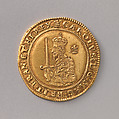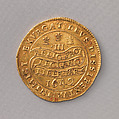Three-pound piece, King Charles I (r. 1625–49)
Struck at The Royal Mint British
Based on an engraving by Simon de Passe Dutch
Not on view
The supplies of bullion brought to Europe from the New World in the sixteenth and seventeenth centuries caused inflation, and in response new coinage was issued with a wider range of denominations. Gold coins like the sovereign, with the value of one pound, twenty shillings, first appeared in 1489. It was replaced by the unite in 1604 and by the guinea in 1663. Initially minted in gold, the crown was also produced in silver from 1551, with standardized dimensions similar to other European coins.
The half-figure of Charles I is taken from an engraving made by Simon de Passe (1595–1647) while he was working for the English court (1615–23).
Due to rights restrictions, this image cannot be enlarged, viewed at full screen, or downloaded.
This artwork is meant to be viewed from right to left. Scroll left to view more.



